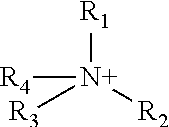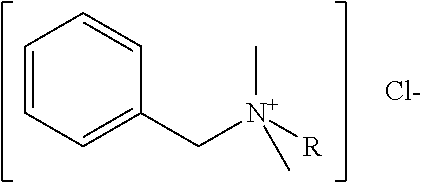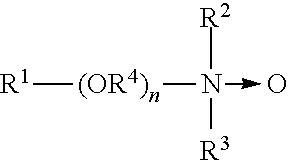Wear resistant antimicrobial compositions and methods of use
a technology of antimicrobial compositions and compositions, applied in the field of antimicrobial compositions, can solve the problems of difficult elimination, health hazards of microorganisms, and increased risk of individual microorganisms, and achieve the effect of improving wear resistan
- Summary
- Abstract
- Description
- Claims
- Application Information
AI Technical Summary
Benefits of technology
Problems solved by technology
Method used
Image
Examples
example 1
Hard Surface Efficacy of PHMB / Quaternary Ammonium Chloride Blend Vs. Stabilized Chlorine Dioxide
[0176]The objective of this analysis was to examine the efficacy of various compositions against Staphylococcus aureus ATCC 6538 and Klebsiella pneumoniae ATCC 4352 after application to inanimate, non-porous, non-food contact surfaces.
Test Method:
Residual Self-Sanitizing Activity on Hard, Non-Porous Surfaces
[0177]Test Surface Preparation:[0178]Clean glass test surfaces were decontaminated by immersing in reagent alcohol and allowing to air dry at room temperature. The test surfaces were dried in sterile glass petri dishes containing 2 layers of Whatman No. 2 paper. Each petri dish had two surfaces in them and were dried for 1 day in a biological safety cabinet with the lids cracked open.
[0179]Test Surface Inoculation and Coating:[0180]The initial inoculum suspension was prepared by making 10−2 and 10−4 dilutions from a 48-54 hour broth culture of the test system. The 10−4 dilution was all...
example 2
Residual Self-Sanitizing Screen of Test Composition A
[0205]The objective of the analysis was to examine the residual self-sanitizing efficacy of against Staphylococcus aureus ATCC 6538 and Klebsiella pneumoniae ATCC 4352 after application to inanimate, non-porous, non-food contact surfaces.
Test Method:
Residual Self-Sanitizing Activity on Hard, Non-Porous Surfaces
Test System Preparation
[0206]1. At least three consecutive loop transfers of a 24 hour culture of Staphylococcus aureus ATCC 6538 and Klebsiella pneumoniae ATCC 4352 were performed in 10 mL of AOAC Synthetic broth or AOAC Nutrient broth (respectively) and incubated at 35° C.[0207]2. Initial Inoculum Suspension:
[0208]2.1 Vortex a 48-54 hour culture for 3-4 seconds.
[0209]2.2 Make two 1 / 100 dilutions in sterile PBDW and let stand for 15±1 minutes.[0210]3. Reinoculation Suspension:[0211]3.1 Vortex an 18-24 hour culture for 3-4 seconds.[0212]3.2 Make two 1 / 100 dilutions in sterile PBDW and on final dilution of 5.0 mL of diluted c...
example 3
Residual Self-Sanitizing Screen of Test Composition C
[0259]The objective of the analysis was to examine the residual self-sanitizing efficacy of Test composition C (a composition according to the invention) against Staphylococcus aureus ATCC 6538 and Klebsiella pneumoniae ATCC 4352 after application to inanimate, non-porous, non-food contact surfaces.
Test Method:
Residual Self-Sanitizing Activity on Hard, Non-Porous Surfaces
Test System Preparation
[0260]1. At least three consecutive loop transfers of a 24 hour culture of Staphylococcus aureus ATCC 6538 and Klebsiella pneumoniae ATCC 4352 were performed in 10 mL of AOAC Synthetic broth or AOAC Nutrient broth (respectively) and incubated at 35° C.[0261]2. Initial Inoculum Suspension:
[0262]2.1 Vortex a 48-54 hour culture for 3-4 seconds.
[0263]2.2 Make two 1 / 100 dilutions in sterile PBDW and let stand for 15±1 minutes.[0264]3. Reinoculation Suspension:[0265]3.1 Vortex an 18-24 hour culture for 3-4 seconds.[0266]3.2 Make two 1 / 100 dilution...
PUM
| Property | Measurement | Unit |
|---|---|---|
| Fraction | aaaaa | aaaaa |
| Fraction | aaaaa | aaaaa |
| Fraction | aaaaa | aaaaa |
Abstract
Description
Claims
Application Information
 Login to View More
Login to View More - R&D
- Intellectual Property
- Life Sciences
- Materials
- Tech Scout
- Unparalleled Data Quality
- Higher Quality Content
- 60% Fewer Hallucinations
Browse by: Latest US Patents, China's latest patents, Technical Efficacy Thesaurus, Application Domain, Technology Topic, Popular Technical Reports.
© 2025 PatSnap. All rights reserved.Legal|Privacy policy|Modern Slavery Act Transparency Statement|Sitemap|About US| Contact US: help@patsnap.com



